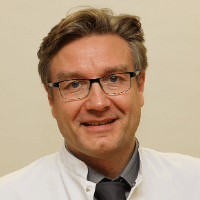Hip Osteoarthritis (coxarthrosis) — Bilateral hip Replacement and Rehabilitation: treatment in the Best Hospitals of Germany
Treatment prices are regulated by national law of the corresponding countries, but can also include additional hospital coefficients. In order to receive the individual cost calculation, please send us the request and medical records.
Treatment of Hip Osteoarthritis (Coxarthrosis) in Germany
- Diagnostics
- Hip replacement
- Arthroscopic surgery
- Diagnosis and conservative treatment
- Hip replacement and rehabilitation
- Endoprosthesis replacement in coxarthrosis
- Endoprosthesis replacement in coxarthrosis with rehabilitation
- Treatment with autologous conditioned plasma (ACP)
- Bilateral hip replacement
- Autologous chondrocyte implantation (ACI)
- Orthopedic rehabilitation

Department of Adult and Pediatric Orthopedics, Trauma Surgery, Foot Surgery, Hand Surgery and Rheumatology
The Department of Adult and Pediatric Orthopedics, Trauma Surgery, Foot Surgery, Hand Surgery and Rheumatology offers the full range of diagnostic and therapeutic services in its areas of specialization. The key areas of work of the department's doctors include large joint arthroplasty, arthroscopic interventions on the knee, hip, and shoulder joints, conservative and surgical treatment of foot and hand diseases and deformities, rheumatic joint lesions, orthopedic diseases in children, and musculoskeletal injuries. The key to successful clinical practice is the professionalism and unique experience of the department's medical team, combined with the advanced infrastructure and state-of-the-art equipment. The department has 5 operating rooms equipped with the latest technology. Most surgical interventions are performed using minimally invasive techniques, due to which, in the shortest possible time, the patient is verticalized, their mobility is restored, and a pronounced pain syndrome is excluded. The department annually performs more than 4,500 surgical interventions, including especially complex ones, so the specialists at the medical facility are rightfully proud of their impressive clinical experience in the surgical treatment of orthopedic diseases. Over the years, the department has gained an excellent reputation not only in Germany but also far beyond its borders.





Department of Adult and Pediatric Orthopedics, Trauma Surgery and Arthroplasty
The Department of Adult and Pediatric Orthopedics, Trauma Surgery and Arthroplasty provides the full range of medical services in the areas of its competence. The department's team of doctors treats patients with diseases and injuries of the musculoskeletal system, joints, bones, tendons, ligaments, and muscles. Orthopedists specialize in partial and total knee, hip, and shoulder replacement surgery, as well as successfully perform revision arthroplasty. Doctors perform arthroplasty at the EndoCert certified Maximum Care Center for Joint Replacement Surgery. The department also has the status of a regional Trauma Center Berlin-Brandenburg, where both common household injuries and severe multiple injuries are effectively treated. The department's team of doctors has a perfect command of advanced conservative and surgical treatment methods in the area of its specialization. Joint replacement surgery is performed here using minimally invasive techniques, which allows the patient to get back on their feet and get rid of pain as quickly as possible. The department has also gained vast experience in arthroscopic treatment of pathologies of large joints and injuries of the tendons, ligaments, and muscles. The department uses an innovative method of cartilage tissue restoration called autologous chondrocyte implantation. Patients of the medical facility receive personalized medical care in comfortable conditions.




Department of Adult and Pediatric Traumatology, Orthopedic Surgery, Spinal Surgery and Foot Surgery
The Department of Adult and Pediatric Traumatology, Orthopedic Surgery, Spinal Surgery and Foot Surgery offers its patients accurate diagnostics and high-quality treatment of the full range of diseases of the musculoskeletal system. The department provides both conservative and surgical treatment of congenital and acquired orthopedic diseases. The medical facility is certified as a regional Trauma Center, so the department's specialists can offer patients of all ages effective treatment for injuries of any severity. The department also has endoCert certification, which confirms the excellent quality of surgery for partial and total knee, hip and shoulder replacement. An equally important focus of the department's work is the treatment of spinal diseases, the excellent results of which are awarded with the certificate of the German Society for Spine Surgery. The department's doctors apply their clinical experience and professional skills to provide optimal treatment and eliminate mobility restrictions for each patient.




According to different authors, bilateral hip replacement for hip osteoarthritis is required in 10-20% of cases. This means that the doctor replaces not one, but both joints affected by the disease at once. The surgical procedure can be performed in one or two stages. Each approach has its own advantages and disadvantages. Both methods are used in Germany. You can visit this country to undergo the surgery safely and with a good functional outcome.
Content
- Principles of hip osteoarthritis treatment
- When should joint replacement be bilateral?
- Pros and cons of two-stage replacement surgery
- Pros and cons of single-stage replacement surgery
- How is the surgery performed?
- After hip replacement
- Why is it worth undergoing surgery in Germany?
- Treatment in Germany with Booking Health
Principles of hip osteoarthritis treatment
Osteoarthritis is a gradual joint degeneration. It occurs slowly but steadily. The cartilage degenerates over time, and the bone located under the cartilage is affected as well.
The disease progresses over decades and does not reverse. So far, there are no ways to restore the patient's own joint, so the treatment is mainly symptomatic. A person reduces the load on the joint: he tries to lose weight, eliminates heavy physical labor, and does physical exercise.
To relieve pain, doctors use nonsteroidal anti-inflammatory drugs. In the beginning, they need to be taken only periodically. Then the need for these drugs arises constantly, and the person takes pills in a continuous course.
The disease gradually reaches 3-4 stages. The pain becomes severe and cannot be relieved with drugs. The person cannot walk, or uses a cane. In 60% of cases, the patient loses the ability to work, and in 10% of cases, he is unable to take care of himself. In such situations, the only effective treatment is joint replacement.
Bilateral hip replacement is substitution of both hip joints with prosthesis in people with bilateral hip osteoarthritis.
Cost of bilateral replacement surgery in hip coxarthrosis is from €24,730. You can find prices for other treatment options and hip rehabilitation on the Booking Health website.
The best hospitals in Germany are:
- University Hospital Rechts der Isar Munich
- University Hospital of Ludwig Maximilian University of Munich
- University Hospital Ulm
- University Hospital Frankfurt-am-Main
- Vitos Orthopedic Clinic Kassel
When should joint replacement be bilateral?
In 80-90% of cases, coxarthrosis affects only one hip. The second hip does not have any signs of degenerative changes or they are not so severe to perform the joint replacement.
In 10-20% of cases, the patient needs to replace both joints at once at the time of diagnosis. It is in such situations that bilateral replacement surgery is performed. It can involve either one or two stages.
A single-stage surgery is used less frequently. Within just one surgical procedure, the doctor removes both of the patient's own joints and replaces them with artificial prostheses. A two-stage method has become more widespread: one hip is replaced first, and after a few months – the second one.
Pros and cons of two-stage replacement surgery
Bilateral hip osteoarthritis is more often treated in two stages. First, one joint is operated, and a few months later – the second one.
The second surgical procedure is most often performed after 3-6 months. During this time, the artificial joint grows into the bone and the operated limb gains support ability. After the second operation, the patient can already bear his entire body weight on it, which facilitates the rehabilitation process.
The timing of another joint replacement surgery may also be different. Sometimes patients are not operated on until 12 months or even later. In other cases, the surgical intervention is performed faster – as early as 2-3 weeks after the replacement of the first joint. Such an approach allows the doctors to reduce health risks, and at the same time, significantly shorten the patient's rehabilitation period.
Total bilateral replacement surgery has the following advantages:
Less health risks. This is especially important for elderly patients with concomitant cardiovascular, oncological, and other diseases. With two-stage treatment, the complications after total hip replacement are less common.
More comfortable rehabilitation. After the first hip replacement, the patient can lean on the leg that has not yet been operated on. By the time of the second surgical intervention, the supporting ability of the operated limb is fully restored. Therefore, after the operation, the patient can already use this leg for support when walking.
Reduced one-time expenses. Not all patients have the means to pay for both joint replacements at once. In addition to the services of surgeons, the patient also needs to buy the prostheses.
The two-stage replacement surgery has the following disadvantages:
Two operations instead of one. Accordingly, the patient undergoes anesthesia, surgery, hospitalization, and rehabilitation twice. Many patients find it difficult to decide on a second operation within a few months after the first, since all the difficulties will have to be endured again.
Long duration of treatment. The time required to obtain the final result of bilateral hip replacement is significantly increased. The patient stays in the hospital twice as long. He spends one and a half to twice as much time on rehabilitation (depending on the timing of the repeat surgery).
Aggravation of coxarthrosis. After the first surgical procedure, the patient will bear his entire body weight to the second affected leg while walking. Therefore, the joint will rapidly degrade, possibly increasing pain and worsening the tolerance of the rehabilitation period.
Higher treatment costs. Two surgeries are more expensive than one. Besides, additional costs are associated with the increased duration of rehabilitation.
Pros and cons of single-stage replacement surgery
Although single-stage bilateral replacement is less common, many hospitals in Germany perform such operations. Their main disadvantages are:
Higher health risks. The operation to replace two hip joints affected by osteoarthritis at once is more traumatic. It continues twice as long. Blood loss also doubles. Some patients need blood transfusion. Doctors try to avoid such operations in people with concomitant pathologies and in old age.
Rehabilitation is more complex. There is no unoperated leg on which the patient can put body weight while walking. After cement fixation, the supporting ability of the operated limbs is restored quickly, but in the early postoperative period the movements are painful, which complicates rehabilitation.
Higher one-time expenses. The patient will have to buy two artificial joints at once. The cost of treatment for the implantation of two endoprostheses is higher than the total replacement of only one joint.
The single-stage total hip replacement has the following benefits:
One operation instead of two. It is psychologically easier for the patient to undergo one surgery and rehabilitation once. In addition, the overall length of stay in the hospital and rehabilitation center is significantly reduced.
Rapid achievement of results. The time from the start of treatment to its final results does not extend over the years, as in the two-stage method. Within a few months after bilateral total replacement, the patient fully restores physical activity.
Correct walking stereotype. The painful joint hurts constantly. Although it may be possible to lean on it earlier after surgery than on the operated leg, functional results may be poorer. Chronic pain and deformity interfere with the formation of the correct walking pattern. If both joints are replaced immediately, the patient will begin to walk later, but the pain will quickly subside, so the static and dynamic function will be better as a result.
Lower cost of treatment. Although the one-time expenses are higher, the treatment will cost the patient less. He will only have to pay for one operation, but not two. The general costs of diagnostics, drugs and rehabilitation are reduced as well. When treated in Germany, then transport costs are reduced in case of the single-stage replacement, and less time will have to be spent in another country.
How is the surgery performed?
Hip replacement surgery is about the same as if the doctor replaced only one of them, and only its duration increases.
The surgery is performed under general or spinal anesthesia. In the second case, the patient is conscious, but does not feel anything, since the sensitivity of the lower half of the body is blocked with the help of drugs at the level of the spinal cord. Spinal anesthesia allows the doctors to start rehabilitation measures earlier, which is especially important for elderly patients and people with concomitant internal pathologies.
The doctor makes a 10 cm incision in the thigh area. He removes the patient's own joint and replaces it with artificial components. In case of hip osteoarthritis, total replacement surgery is performed. This means that not only the femoral, but also the pelvic part of the joint is replaced.
Its femoral part consists of a leg, a neck and a head. The stem becomes an extension of the patient's own femur. The femoral head provides mobility to the joint: it rotates in the acetabulum.
The pelvic part is the artificial acetabulum. It is called a cup. To soften friction, a liner is located in it. It separates the cup from the head of the artificial hip.
The doctor can fix the components of the endoprosthesis using ether cement or cementless methods. In the second case, artificial materials are attached with screws. They gradually grow into bone.
Upon the completion of the surgery, the doctor sutures the wound. Drains are left in the wound to allow blood and lymph (clear fluid) to drain out. The drains are removed after 1-2 days.
After hip replacement
After the operation, the patient lies mainly on his back, but he can turn on his side. A roller is placed between the legs. The operated joint is in the abduction position. While lying in bed, the patient can start exercising to maintain good blood circulation. In this case, the patient is advised to avoid sudden movements, strong flexion of the limb and rotation of the hip joint.
For the first time after hip replacement, pain appears. The doctors prescribe painkillers to relieve pain. Additional drugs are required to reduce the risk of infectious and thromboembolic complications. For the same purpose, elastic bandaging of the legs is carried out.
In the first two weeks, the early phase of rehabilitation takes place. During this period, soft tissues heal. They are swollen and inflamed. The main task of rehabilitation measures is to prevent complications, reduce edema and improve blood circulation.
The patient does exercises. First, he does them while lying in bed. Then he walks using crutches or walkers. The load on the operated limb gradually increases. The timing of its completion to the maximum depends on the type of operation performed and the method of fixing the prosthesis. After cement fixation, the maximum load on the thigh can be applied earlier.
The most intense recovery starts from the second month. The support ability of the limbs is gradually increased. A person can increase physical activity.
The doctors in German rehabilitation centers individually select a program for patients. The patient trains on the most advanced simulators. Robotic systems and exoskeletons are often used as well. The specialists constantly monitor the patient's condition and promptly adjust the type of exercises and the levels of load. To improve the effectiveness of rehabilitation after hip replacement, doctors use physiotherapy procedures.
Why is it worth undergoing surgery in Germany?
The hospitals in Germany perform hip replacement very often. This is the most common orthopedic surgery. Large hospitals perform thousands of such procedures every year. Doctors have vast experience in both unilateral and bilateral joint replacement surgeries.
Here are some reasons why you should undergo hip osteoarthritis treatment in Germany:
- Safe surgery with minimal risk of complications.
- Implantation of endoprostheses through short incisions.
- High-quality postoperative care and recovery.
- Full-fledged rehabilitation, which helps the person to recover in a few months, even after the simultaneous replacement of both hip joints.
- High-quality endoprostheses, which will serve for decades.
- The risk of necessity for the second surgery to replace the components of endoprosthesis in the future is minimal.
German orthopedic hospitals have state-of-the-art equipment and employ the best doctors in the world.
Treatment in Germany with Booking Health
To undergo hip replacement surgery in one of the best medical hospitals in Germany, please use the Booking Health services. On our website, you can see the cost of treatment in different German hospitals, compare prices and book a medical care program at an affordable price.
Please contact the Booking Health specialists to undergo treatment in Germany. Here are our benefits for you:
- We will choose the best hospital whose doctors specialize in hip replacement surgery.
- We will help you overcome the language barrier, establish communication with the German hospital and your attending physician.
- We will reduce the waiting time for the medical program and book a doctor's appointment on the most suitable dates.
- We will reduce the price. The cost of treatment in Germany will be decreased due to the lack of additional coefficients for foreign patients.
- We will take care of all organizational issues: documents for entering the country, transfer from the airport, hotel, interpreter, etc.
- We will prepare a medical care program and translate medical documents into German. You do not have to undergo previously performed diagnostic tests.
- We will provide communication with the hospital after the completion of treatment in Germany.
- We will organize additional medical examinations, treatment in Germany or rehabilitation, if necessary.
- We will buy medicines in Germany and forward them to your native country.
- We will help you keep in touch with the hospital after treatment in Germany.
Booking Health makes treatment in Germany easier, faster and cheaper. We will fully organize your trip, and you will only have to focus on restoring your health.
Authors:
This article was edited by medical experts, board-certified doctors Dr. Nadezhda Ivanisova, and Dr. Bohdan Mykhalniuk. For the treatment of the conditions referred to in the article, you must consult a doctor; the information in the article is not intended for self-medication!
Our editorial policy, which details our commitment to accuracy and transparency, is available here. Click this link to review our policies.

